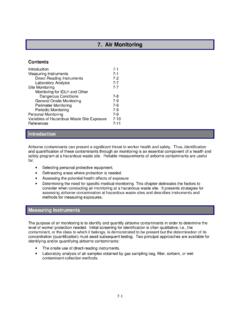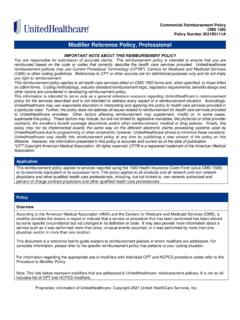Transcription of Centralized Vs Decentralized Air Conditioning Systems
1 Centralized Vs Decentralized Air Conditioning Systems Course No: M05-012. Credit: 5 PDH. A. Bhatia Continuing Education and Development, Inc. 9 Greyridge Farm Court Stony Point, NY 10980. P: (877) 322-5800. F: (877) 322-4774. Centralized Vs Decentralized Air Conditioning Systems Abstract Commercial air Conditioning may be provided by a variety of equipment ranging from low horsepower self-contained Systems to the very large built-up central Systems of several thousand ton capacity. Customer/user's ultimate objective is to acquire and utilize an air Conditioning system that will provide the most appropriate performance on a whole of life basis, in terms of capital, operating, replacement and maintenance costs.
2 It's the architect's/HVAC engineer's responsibility to guide and advise the customers the best option. HVAC Systems are of great importance to architectural design efforts for four main reasons. 1. First, the success or failure of thermal comfort efforts is usually directly related to the success or failure of a building's heating, ventilation and air Conditioning (HVAC) Systems ;. 2. Second, HVAC Systems often require substantial floor space and/or building volume for equipment and distribution elements that must be accommodated during the design process;. 3. Third, HVAC Systems require significant capital investments;. 4. Last, but not least, the HVAC system is responsible for large portion of building operating costs.
3 The design and selection of right HVAC system therefore must combine a proper choice of engineered products efficiently providing conditioned air to the space at optimum energy while adding architectural features that shall complement the interior design. This 5 - hr course discusses the various issues to be considered and the questions to be raised before an intelligent, well-thought HVAC scheme is finalized. The advantages and disadvantages, which arise as a result of Centralized or Decentralized air Conditioning Systems , are evaluated in this course. PART 1 TYPE OF AIR Conditioning Systems . Investment in a building project entails significant capital investment and associated costs over the economic life of the project.
4 It is a mistaken notion that the buildings costs have to be expensed once. The buildings like any other industry have running expenses in a way that they consume lot of energy and require water and disposal facilities that accounts for significant recurring costs. While there are many different HVAC system designs and operational approaches to achieving proper system functionality, every building is unique in its design and operation. For instance residential apartments, shopping complex, office complex, hospital, hotel, airport or industry; all have different functional requirements, occupancy pattern and usage criteria. The geographical location of the building, ambient conditions, indoor requirements, building materials, dimensional parameters, aesthetic requirements, noise and environment issues need different treatment.
5 The HVAC design options must therefore be customized to satisfy the owner's business needs, architect's vision combined with operational and maintenance requirements of the facilities manager. The selection of most appropriate HVAC system is related to various parameters, including but not limited to: Parameters HVAC Challenges Thermal Comfort The internal environment of the buildings must be a major focus point in the HVAC system selection. A number of variables interact to determine whether people are comfortable with the temperature of the indoor air. The activity level, age, and physiology of each person affect the thermal comfort requirements of that individual.
6 The American Society of Heating, Refrigerating, and Air- Conditioning Engineers (ASHRAE). Standard 55-1981 describes the temperature and humidity ranges that are comfortable for most Parameters HVAC Challenges people engaged in largely sedentary activities. Building Architecture The HVAC system selection is influenced by the characteristics of the building such as: Purpose of the building, area classification, occupancy and usage patterns;. Type of building structure, orientation, geographical location, altitude, shape, modules- size and height;. Materials and thickness of walls, roof, ceilings, floors and partitions and their relative positions in the structure, thermal and vapor transmittance coefficients, areas and types of glazing, external building finishes and color as they affect solar radiation, shading devices at windows, overhangs, etc.
7 ;. Ratio of internal to external zones, glazing, plant room sitting, space for service distribution;. Foundation and supports requirement, permissible loadings. Available Space Considerable space is needed for mechanical rooms to house the HVAC equipment. In addition shaft spaces are required for routing ducts/pipes and other services electrical and plumbing work. Early liaison is therefore required with the Parameters HVAC Challenges project architect to proportion the building that would be occupied by HVAC Systems , as this will have an impact on the size and cost of the building. Building ceiling heights The HVAC designer must thoroughly evaluate the ceiling space for air distribution ducts.
8 Low ceiling height clearance between suspended ceilings and roof (also called plenum space) require close co- ordination with structural group for location and size of structural beams. Inadequate spaces to run ducts, probably force the system designer to use Decentralized or unitary air Conditioning units. The HVAC layout should be complementary to the Building Aesthetics building architecture. Often the requirements are stringent for example: No equipment should be visible or should suitably blend with environment Size and appearance of terminal devices in ceiling shall harmonize with lighting layout, fire sprinklers, detectors, communication Systems and ceiling design.
9 Acceptability of components obtruding into the conditioned space;. Accessibility for installation of equipment, space for maintenance;. Parameters HVAC Challenges Location of fresh air intakes and exhausts, fire zones and fire walls;. Indoor and outdoor equipment preferences etc. Efficiency/Performance and To assemble the best HVAC system, the Energy Use efficiency, performance, cost and energy use will be major considerations when selecting components for the system. The equipment selected must conform or excel beyond the constraints presented in ASHRAE Standard The cost of the energy consumed by the components of the HVAC system is an important aspect of the system selection.
10 Each component must use as little energy as possible and still meet the performance requirements. Efforts should be on improving the building Green Star rating and obtaining Leadership in Energy and Environment Design (LEED) certification. Issues such as integration of the proposed system with the Building Management System, existing plant types etc must be taken into consideration as well. Availability of water The places where water is scarce, the only choice leans towards air-cooled equipment. In other public places such as hospitals, the air cooled equipment is sometime preferred due to potential concerns of Legionalla disease associated with Parameters HVAC Challenges water cooling.






